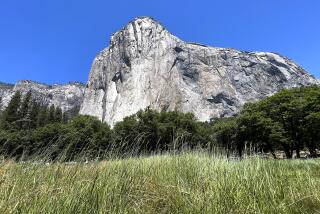EPA Backs Haze-Free Vistas in National Parks
- Share via
WASHINGTON — Environmental Protection Agency Administrator Christie Whitman announced plans Tuesday to move forward on a Clinton administration proposal to clear the haze from national parks and other wilderness areas by helping states reduce pollution from aging power plants and other industrial facilities.
“Part of the president’s commitment to protecting national parks includes protecting the views that draw us to these parks year after year,” Whitman says. “But over the years, haze and pollution have eroded these vistas.”
The proposal was one of dozens of environmental actions taken in the waning weeks of the Clinton administration that the Bush White House had stalled. Although the administration has reversed other Clinton-era regulations, Tuesday’s decision marked the second Clinton rule aimed at reducing air pollution that the new administration has since embraced. The first required a massive reduction in the sulfur content of diesel fuel.
Tuesday’s action, coming a day before Bush is scheduled to tour California’s Sequoia National Park, was greeted cautiously by an environmental community that has harshly criticized the president’s early record on the environment.
“Ultimately, it should lead to a pretty big reduction in pollution,” said Frank O’Donnell of the Clean Air Trust. He added that he wanted to see the administration’s final rule, which would be drafted after a 60-day public comment period, before embracing the decision.
Pollution has steadily been degrading the visiting experience in some parks. Perhaps hardest hit has been Great Smoky Mountains National Park, where visibility has been cut by as much as 80%.
Amendments to the 1990 Clean Air Act required the EPA to establish a rule to improve visibility in 156 national parks and wilderness areas and required older power plants to install the best air pollution controls available.
California has been directed to clean the air at 29 parks and wilderness areas, including Yosemite, Joshua Tree, Lassen, Sequoia/Kings Canyon and Point Reyes. At Sequoia, air quality during summer months is considered unhealthful because of excess ozone as much as one in every three days.
The proposal endorsed by the Bush administration Tuesday would guide states as they decide which facilities must install air pollution controls and what devices they should install.
The targeted facilities were built between 1962 and 1977 and emit more than 250 tons of visibility-impairing pollutants every year. They are coal-fired power plants, industrial boilers, refineries and iron and steel plants, among others.
The deadline for cleanup would be 2013, according to the EPA.
EPA officials said there was no substantial difference between the proposals unveiled by the Clinton and Bush administrations.
Environmentalists were miserly with their praise for the Bush administration’s action, because they say it must be taken in the context of an overwhelmingly negative overall policy toward the environment and the parks.
For instance, the Bush administration’s comprehensive energy policy advocates the expansion of energy production through burning fossil fuels, rather than stressing conservation or much broader use of renewable energy sources such as wind and solar power.
However, the plants targeted by Tuesday’s proposal are some of the heaviest polluting facilities in the country, because to date they have not been required to use devices that can greatly reduce harmful emissions of nitrogen oxides and sulfur dioxides. So, if adopted, the proposal would clearly prod states toward action that could clean up the air.
“It’s definitely a positive step,” said Ron Tipton, vice president of the National Parks Conservation Assn.
But Tipton quickly added that it would not change the overall “D” grade that his group gave the president Tuesday for his policies towards the parks. Bush earned this grade even though he has pledged to increase funding for park maintenance projects by $4.9 million over the next five years.
Meanwhile, industry officials attacked the decision as too expensive and contrary to the president’s stated goal of increasing the supply of electricity.
“This promises to be far more expensive than earlier EPA estimates gave us,” said John Grasser, spokesman for the National Mining Assn. He said that it could close down some small power plants “even though this would fly in the face of our national energy strategy, because it comes at a time when we need all the additional electric capacity we can get.”
More to Read
Sign up for Essential California
The most important California stories and recommendations in your inbox every morning.
You may occasionally receive promotional content from the Los Angeles Times.










